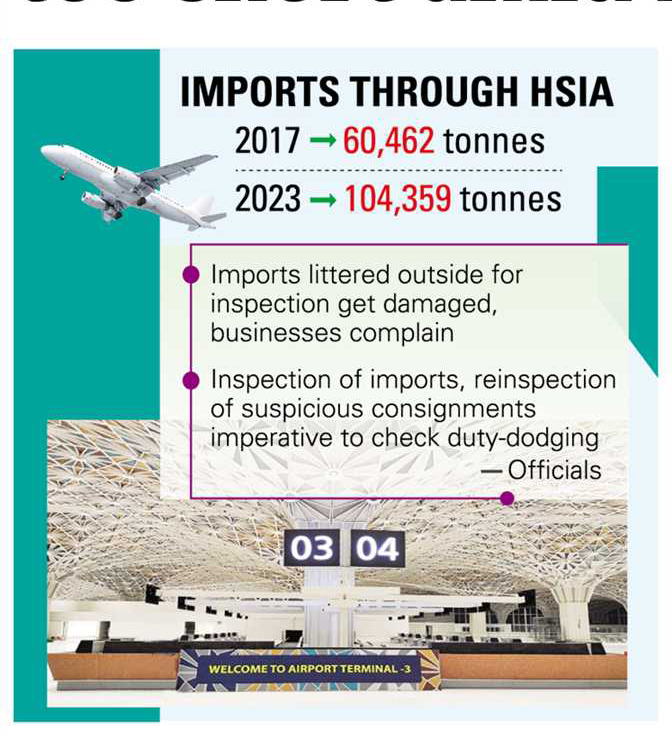
Customs find several HSIA new terminal flaws
Trade-cargo accommodation too short amid import surge
DOULOT AKTER MALA | Friday, 28 June 2024
Dhaka airport's much-vaunted new terminal is found wanting on several counts in customs test, including inadequate capacity to accommodate burgeoning trade cargos until checking against tax evasion.
Official sources said Bangladesh customs found such limitations, including insufficient spaces in cargo villages, in the third terminal of the Hazrat Shahjalal International Airport (HSIA) that now gets paint-and-brush touches ahead of the finish.
Following a sharp increase in the import of goods for consumption and production, the authority has identified the storage of capacity of the complex alone to hold this all.
In 2023, some 104,359 tonnes of imports arrived in the HSIA in a rise from 60,462 tonnes in 2017, attuned to an expanding economy.

Currently, the customs authority in HSIA conducts 100-percent physical examination of most commercial import of goods to check duty-evasion.
A committee formed by Dhaka Customs House (DCH) has pointed out the challenges in its recent report, submitted to the National Board of Revenue (NBR).
Headed by Additional Commissioner of DCH Kazi Farid Uddin, the panel has assessed the capacity of cargo-terminal building after physical inspections. There was made a review of the building designs of the terminal to find whether it is aligned with the exiting business process of customs.
The new import-cargo complex or ICC has 109,462 sq ft space. Customs have found it insufficient for the assessment period before release of imports.
In the report, seen by the FE correspondent, the committee has recommended allowing the use of both existing and new-import-cargo complexes after formal launch of the new terminal.
Customs need to store the import cargos in ICC until the process-starting from submission of IGM to goods release-all completes. Businesses have long complained of damage to their imported goods because of insufficient storage facility in the ICC of HSIA.
More often than not, import goods often get damaged in rain or sunlight as the customs authority has to keep those under the open sky for not having spaces in ICC, officials said.
Visiting the third terminal, the committee members have found no examination yard for physical inspection of import goods. Also found is the necessity of additional manpower and logistics to conduct customs activity in the newly constructed terminal.
For reinspection of suspicious import consignments regarding false declaration, the third terminal has no USS (ULD Storage System) or ASRS (Automated Storage and Retrieval System) either.
The import-cargo village was established in 1991 at the country's main gateway, HSIA, on 266,008-square- foot spaces. Some 122,188 square feet are being used for import-goods storage while the rest of the paces for office, passage for goods movement, auction and disposal.
"Considering risk of revenue loss through false declaration of goods, the DCH currently inspects all import goods physically, save a few," says one customs official.
The third terminal has been constructed focusing on fully automated system having no scope to inspect commercially imported goods, he observes.
The committee has informed the CAAB, HSIA expansion project office about the shortcomings on an urgent basis.
"Commercially imported goods having high duty taxes are vulnerable to duty evasion as the practice is rampant in the country," the customs official says about the tricks of the trade linked to huge leaks of state revenues that economists see as a major factor for the country's financial constraints and consumer woes.
Chairman of the Civil Aviation Authority of Bangladesh Muhammad Mafidur Rahman says they have received the observation of the customs and requested the Japanese contractors to address the problems.
"The terminal would be operational only after the Japanese contractor completes necessary works," he adds, indicating scope of remediation.
The customs committee has found the necessity of manpower and equipment, including pallet scanner machine, computer and furniture, to check import-export activities and passenger movement in the third terminal.
"Customs officials would not be able to assess payable duty taxes on red- channel-category goods unless they inspect those physically," the report reads.
The report recommends that the ICC in old air-freight unit could be used in this regard.
However, import goods released on second appraisement of the customs act such as industrial, goods imported by export-oriented industries under bonded- warehouse facility, and Authorized Economic Operator could be released through the new terminal.
After the scanning of goods, the new terminal has no facility to re-store the goods in Automated Storage and Retrieval System after the checking with scanner.
As per customs act, the customs authority needs to re-store the goods if any misdeclaration detected in scanning. Absence of such facility contradicts the law.
"The number and weight of commercially imported goods cannot be assessed only in scanning. It may cause revenue loss of the government," the investigation report says.
Even some of the industrial goods also need to be inspected physically to determine payable duty taxes.
The construction contract was awarded to Aviation Dhaka Consortium. The consortium includes Japan's Mitsubishi and Fujita and South Korea's Samsung. The terminal is based on a design by internationally renowned architect Rohani Baharin.
The soft opening of the third terminal by Prime Minister Sheikh Hasina on October 7, 2023 raised hope for doubling the capacity of the country's largest airport.
doulotakter11@gmail.com